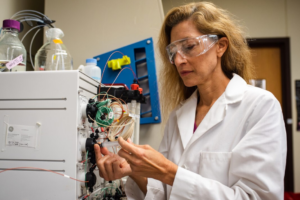When it comes to interest in science, most people enter the world on a level playing field. Boys and girls alike experience a natural sense of wonder at the world around them. Whether watching a butterfly emerge from its cocoon or watching a meteor shower while lying on the grass, children start life with the innate curiosity every scientist needs.
Think of how they take things apart to see how they work, challenge one another with math puzzles and problem-solving games, and collect stray bugs and animals — my own childhood choice, an opossum, is not recommended. So why, in later years, do so few girls and women wind up exploring careers in science and math?
Culture and history, not nature, create most of the discrepancy between men and women in science, technology, engineering and math, or STEM. Previously, our society saw no role for women in these fields, and such barriers take time to break down.
Yet we know that school children are motivated to perform well in science and math, regardless of gender. And recent data indicate there’s little to no difference in ability between female and male students — especially in countries where the culture values having both in the sciences.
In declaring Feb. 11 the International Day of Women and Girls in Science, the United Nations highlights that just 28 percent of current researchers worldwide are women. The proportion in the U.S. is very similar. And in Texas, college-bound boys are more than three times as likely as girls to express an interest in a STEM major, according to The Alliance for Science & Technology Research in America.
We need to keep more women, as well as people of color, engaged with science. It’s in our national interest. Having careers in science and math remain largely the purview of a minority of the population severely limits our talent pool. That’s a threat for large sectors of the economy — and for our ability as a nation to problem-solve some of society’s biggest challenges, from infrastructure to disease to climate change.
What’s more, having more women and people of color on teams improves scientific outcomes: Researchers have found that scientific papers with more diverse authorship receive more citations, and that a tech startup or pharmaceutical company with more women on its board of directors is more likely to succeed.
Why this occurs isn’t clear. Whatever the reason, what is clear is that increasing underrepresented groups’ numbers in STEM fields has the potential to transform research and large sectors of the economy.
I’ve thought about this a lot since the December death of groundbreaking scientist Vera Rubin. She discovered evidence of dark matter, but she faced numerous unnecessary barriers in her work.
I can only imagine what she might have accomplished if her pursuit of astronomy had been helped, rather than hindered, by some of the people around her.
When I consider how I wound up a scientist, I credit my parents who nurtured my curiosity, tolerating the insect collections and pet opossum, and teachers who encouraged me.
When I arrived at the points in my career where relatively few women remained, I retained a stubborn love for science and had supportive male mentors who didn’t treat women in laboratories as an unknown species.
I was fortunate. But luck shouldn’t determine whether a promising student stays in science. We need to take advantage of the potential in bright and curious girls, allowing them to be as successful as their male counterparts.
That starts with removing all the artificial barriers to success. Parents and teachers can help work against cultural biases, by encouraging and nurturing their daughters’ and female students’ early interest in science. And people in leadership — from elected officials to school principals — can speak up for a vision of a future STEM workforce that reflects the population as a whole.
Women don’t need token accommodations or to be treated as an afterthought. Their value is inherent. But from preschool to graduate school and beyond, we must support girls and boys, men and women. It’s on all of us to foster future interest in STEM and help our children develop the necessary skills to succeed. Our society will benefit from it.
Shelley Payne is a professor of molecular biosciences at The University of Texas at Austin.
A version of this op-ed appeared in the Dallas Morning News, Rio Grande Guardian, and Psychology Today.
To view more op-eds from Texas Perspectives, click here.
Like us on Facebook.




